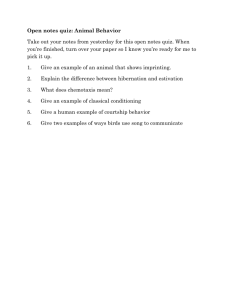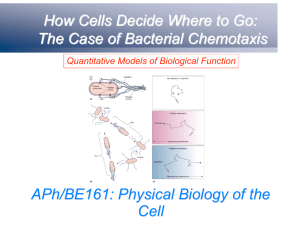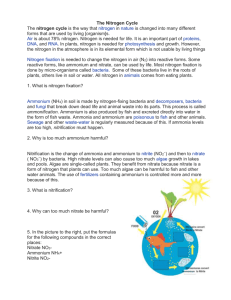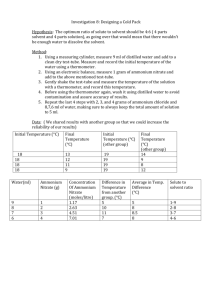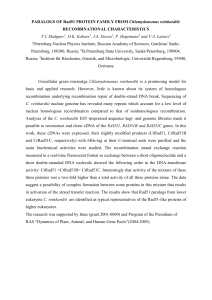Protistology Сhemotaxis of Chlamydomonas reinhardtiito nitrate is
advertisement
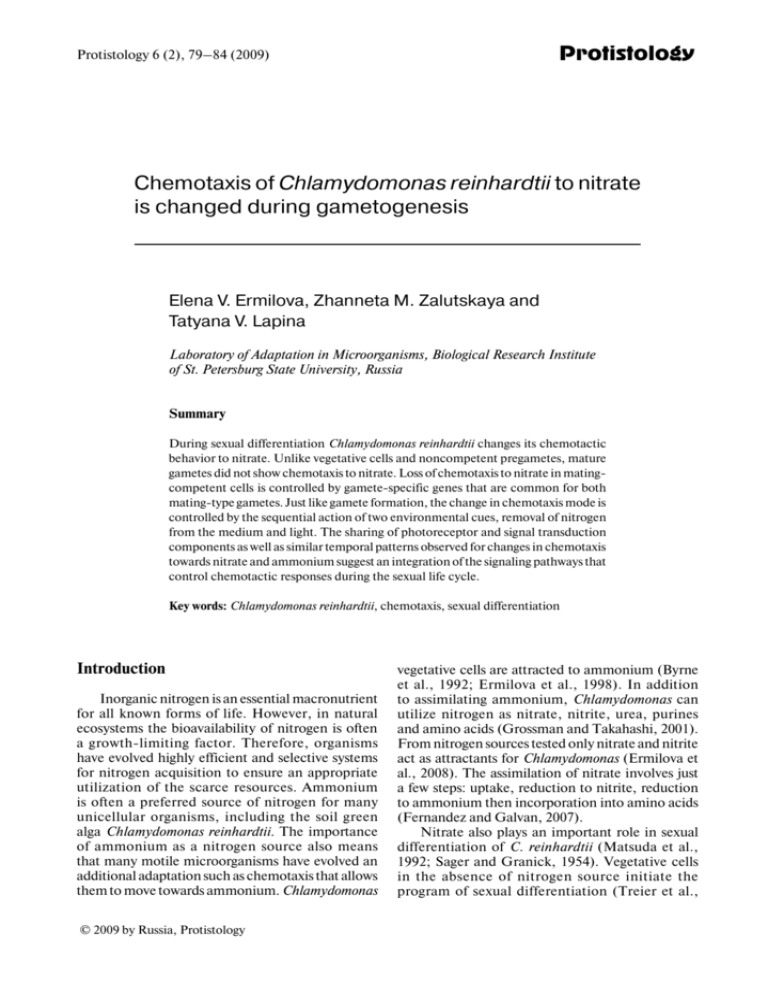
Protistology Protistology 6 (2), 79–84 (2009) Сhemotaxis of Chlamydomonas reinhardtii to nitrate is changed during gametogenesis Elena V. Ermilova, Zhanneta M. Zalutskaya and Tatyana V. Lapina Laboratory of Adaptation in Microorganisms, Biological Research Institute of St. Petersburg State University, Russia Summary During sexual differentiation Chlamydomonas reinhardtii changes its chemotactic behavior to nitrate. Unlike vegetative cells and noncompetent pregametes, mature gametes did not show chemotaxis to nitrate. Loss of chemotaxis to nitrate in matingcompetent cells is controlled by gamete-specific genes that are common for both mating-type gametes. Just like gamete formation, the change in chemotaxis mode is controlled by the sequential action of two environmental cues, removal of nitrogen from the medium and light. The sharing of photoreceptor and signal transduction components as well as similar temporal patterns observed for changes in chemotaxis towards nitrate and ammonium suggest an integration of the signaling pathways that control chemotactic responses during the sexual life cycle. Key words: Chlamydomonas reinhardtii, chemotaxis, sexual differentiation Introduction Inorganic nitrogen is an essential macronutrient for all known forms of life. However, in natural ecosystems the bioavailability of nitrogen is often a growth-limiting factor. Therefore, organisms have evolved highly efficient and selective systems for nitrogen acquisition to ensure an appropriate utilization of the scarce resources. Ammonium is often a preferred source of nitrogen for many unicellular organisms, including the soil green alga Chlamydomonas reinhardtii. The importance of ammonium as a nitrogen source also means that many motile microorganisms have evolved an additional adaptation such as chemotaxis that allows them to move towards ammonium. Chlamydomonas © 2009 by Russia, Protistology vegetative cells are attracted to ammonium (Byrne et al., 1992; Ermilova et al., 1998). In addition to assimilating ammonium, Chlamydomonas can utilize nitrogen as nitrate, nitrite, urea, purines and amino acids (Grossman and Takahashi, 2001). From nitrogen sources tested only nitrate and nitrite act as attractants for Chlamydomonas (Ermilova et al., 2008). The assimilation of nitrate involves just a few steps: uptake, reduction to nitrite, reduction to ammonium then incorporation into amino acids (Fernandez and Galvan, 2007). Nitrate also plays an important role in sexual differentiation of C. reinhardtii (Matsuda et al., 1992; Sager and Granick, 1954). Vegetative cells in the absence of nitrogen source initiate the program of sexual differentiation (Treier et al., 80 · Elena V. Ermilova, Zhanneta M. Zalutskaya and Tatyana V. Lapina 1989). The initial step in the sexual life cycle of C. reinhardtii is the differentiation into gametes. During gametogenesis haploid vegetative cells are converted into mating-competent gametes. This gametic differentiation has been shown to be associated with changes not only in the cells’ biochemistry and subcellular morphology (Beck and Haring, 1996) but also in their chemotactic behavior to ammonium (Ermilova et al., 2003). Mature gametes do not exhibit chemotaxis to ammonium. Like the development of mating competence the loss of chemotaxis to ammonium requires the action of two environmental signals: lack of a nitrogen source and blue light (Ermilova et al., 2003). We have shown that the photoreceptor, which mediates the loss of chemotaxis to ammonium during gametogenesis, is phototropin (Ermilova et al., 2004). Phototropin in C. reinhardtii also controls the progression of the sexual life cycle of this green alga (Huang and Beck, 2003). We suggest that loss of chemotaxis towards nitrogen sources by gametes, which are known to play a key role in the repression of their sexual differentiation, may be viewed as one of the cellular adaptations to changing environmental conditions. To test this hypothesis, we have studied chemotaxis of Chlamydomonas reinhardtii to nitrate during the sexual life cycle. Here we report on differences between pregametes and gametes in chemotaxis to nitrate. The data obtained indicate also that the mechanisms may be shared in the control of chemotaxis to ammonium and nitrate in life cycle of Chlamydomonas. Material and methods Strains and culture conditions Chlamydomonas reinhardtii wild-type strain CC-124 (mt -), obtained from the Chlamydomonas Culture Collection at Duke University, Durham NC, USA, was used as the tester strain. Another wild-type strain used was CC-620 (mt +), obtained from Dr. S. Purton, University College London, UK. Strains RNAi20 (mt -) with reduced levels of phototropin and CF59 with light independence in gamete formation have been described previously (Huang and Beck, 2003; Dame et al., 2002). Cells were grown at 22° C under a 12-h light/12-h dark regime in Tris acetate phosphate (TAP) medium (Gorman and Levin, 1965) or in an acetate-free TAP (TMP) medium. Cells were grown at 22° C under a 12-h light/12-h dark regime in Tris-acetatephosphate (TAP) medium (Gorman and Levin 1965) or in acetate-free TAP (TMP) medium. Generation of pregametes and gametes For the generation of pregametes, liquid cultures of synchronously growing cells at the beginning of the light period were washed with nitrogen-free medium (TAP-N or TMP-N), resuspended in the same medium at a density of 0.1-1.0 × 106 cells/ml and incubated in the dark for at least 4 h. Gametes were obtained either by incubation of vegetative cells in nitrogen-free medium with continuous illumination (fluence rate 30 µmolm-2s-1) or from pregametes by exposing them to light. The light source used was a 500W lamp (LOMO, Russia) mounted in a slide projector. Chemotaxis assay Chemotactic responses were tested by counting the number of cells that in darkness swam into rectangular capillaries (260 µm × 450 µm) filled with 3 µl of medium containing either 5 mM KNO3 or the tested N source. This number was compared to the number of cells entering capillaries filled with nitrogen-free medium (Ermilova et al., 1998). Capillaries were closed at one end with Parafilm. The other end was submerged in the cell suspension for 10 min at 22°C. The chemotaxis index (CI) was calculated using the following ratio: CI = number of cells entering capillaries filled with medium containing the tested media number of cells entering capillaries filled with nitrogen-free medium Switch-off of chemotaxis was recorded as 1.0. Data are means ± SD of triplicate determinations from a representative experiment from at least three different ones. Determination of mating competence The percentage of gametes CC124 (mt -) was assayed by mixing the cells with a threefold excess of gametes of mt +. The mating was allowed to proceed in the dark for 1h and stopped by adding glutaraldehyde (final concentration 0,5%). The numbers of biflagellate cells and quadriflagellate cells in the mating mixture were microscopically recorded. The mating competence was calculated as described by Beck and Acker (1992). Protein Extraction and Immunoblot Analyses Cells were sedimented by centrifugation (3.000 g for 5 min) and resuspended in 0.1 M Protistology DTT/0.1 M Na2CO3. Then, 0.66 vol of 5% SDS/30% sucrose was added for cell lysis. In cases where the lysates were too viscous, samples were sonicated. Solubilization of proteins was aided by rapid shaking at room temperature for 20 min. The protein concentration was determined by staining with amido black, using BSA as a standard (Popov et al., 1975). After separation of the proteins by 12% acrylamide SDS/PAGE (Laemmli, 1970), they were transferred to poly(vinylidene difluoride) (PVDF) membranes (Hybond-P, Amersham Biosciences). Peroxidase-conjugated anti-rabbit serum (Sigma) was used to detect the primary rabbit Abs directed against C. reinhardtii phototropin (Huang et al., 2002) and plastidic cochaperone CGE1 (Schroda et al., 2001). For signal detection we used the enhanced chemiluminescence system (Amersham Biosciences). · 81 Fig. 1. Chemotactic responses of vegetative cells and gametes of mt + (■) and mt - (□) towards nitrate. The nitrogen source was removed at time 0. Incubation was performed with continuous illumination. Data are means ± SD of 5 independent experiments. Results capable to complete the program of differentiation. The results demonstrate that nitrogen deprivation is not enough to change the mode of chemotactic behavior to nitrate. Chemotaxis of gametes to nitrate Role of light in change of chemotactic behavior during gametogenesis We wondered whether gametes react chemotactically to nitrate. Chemotaxis to nitrate, as also described for ammonium (Ermilova et al., 2003), was a property of vegetative cells but not of gametic cells (Fig. 1). C. reinhardtii is isogamous species which means that there are no major morphological differences between mt + and mt - gametes. Mating type is controlled by the mating-type locus. A comparison of chemotactic responses between vegetative cells and gametes of both mating types is shown in Fig. 1. After illumination for 24 h in nitrogen-free medium, Chlamydomonas cells of both mating types differentiate into gametes that were unable to perform chemotaxis to nitrate. Therefore, a loss of chemotaxis to these nutrients in gametes is not sex-specific. Pregametes exhibit chemotaxis to nitrate. Effective formation of mating ability was shown to be dependent on removal of nitrogen from the medium and on the presence of light (Beck and Haring, 1996). We next tested whether the both environmental signals must be provided for a loss of chemotaxis to nitrate. For this purpose, vegetative cells were incubated in TAP-N in the dark. Nitrogen starvation in the dark induces a program of differentiation resulting in cells, which were called pregametes (Treier and Beck, 1991). Figure 2 shows that pregametes are attracted to nitrate. Even though acetate as source of carbon and energy was present in the nitrogen-free medium, cells were not The differentiation of vegetative cells into sexually mature cells in C. reinhardtii may proceed in two steps (Beck and Acker, 1992). Nitrogen starvation induces the first step that results in sexually noncompetent pregametes. In the second step, these pregametes may be converted into mating-competent gametes by irradiation with light. We wondered if these two signals might also act on change of chemotaxis sequentially. For these tests, pregametes, generated from vegetative cells by incubation in the dark without an utilizable nitrogen source, were exposed to light. As shown in Fig. 2, the light induced switch-off chemotaxis in cells. Therefore, the change of chemotactic behavior to nitrate may be divided into the light-independent and light-dependent steps, like the formation of competence ability. Chemotactic behaviour mutant CF59 in blue-light signaling To learn more about the regulation of change in chemotactic behavior by light, we analyzed the chemotactic responses in mutant CF59. This mutant has the capacity to form mating competent gametes in the dark (Dame et al., 2002); it also shows loss of chemotaxis to ammonium in the absence of light (Ermilova et al., 2006). The same results were observed for nitrate that do not attract pregametes of CF59 (Fig. 3). 82 · Elena V. Ermilova, Zhanneta M. Zalutskaya and Tatyana V. Lapina Fig. 2. Chemotactic responses of pregametes (●) and gametes obtained from pregametes (○) towards nitrate. Vegetative cells of mt - were resuspended in TAP-N at time 0. The percentage of mating (D) is given for a comparison. At the times indicated, cells were mixed with an excess of sexually competent mating partner, and incubated in the dark. After 1h, the cells were fixed by the addition of glutaraldehyde and relative mating was determined as described in Materials and methods. Data are means ± SD of triplicate determination from a representative experiment. Effect of reduced phototropin level on changes in chemotactic behavior to nitrate and nitrite We have shown previously that RNA-interference strains with reduced levels of the blue-light receptor phototropin showed an attenuated inactivation of chemotaxis to ammonium (Ermilova et al., 2004). To determine if phototropin was involved in changes in chemotactic activity to nitrate, we tested the chemotactic behavior of the strain that harboured RNAi construct for Phot and exhibited reduced phototropin level. The RNAi20 strain, having severely reduced phototropin levels (Ermilova et al., 2004), exhibited a switching-off of chemotaxis at a fluence rate of 60 µmol m-2 s-1, however, with a delay of about 2 hours when compared to the parental wild-type strain CC-124 (Fig. 4). Thus, the kinetics of the loss of chemotaxis to nitrate and nitrite correlate with the level of Phot protein detected by specific antibodies. We conclude that phototropin is the likely photoreceptor used by blue light to control the switch-off of chemotaxis to nitrate during gametogenesis. Discussion Here we report on the alteration of chemotaxis to nitrate during the sexual life cycle of C. reinhardtii. While vegetative cells exhibit chemotaxis towards nitrate in the light and in the dark, gametes are devoid Fig. 3. Chemotactic responses of CC124 (○) and the mutant CF59 (●) towards nitrate. Incubations were performed in the dark. The nitrogen source was removed at time 0. Data are means ± SE from 3 independent experiments. of this response (Fig. 1). Loss of chemotaxis to ammonium in mating-competent cells is controlled by gamete-specific genes that are common for both mating-type gametes. This change in chemotactic behavior requires the sequential action of two environment cues: nitrogen deprivation and light. Thus, cells starved for nitrogen in the dark still exhibit chemotaxis (Fig. 2). These cells, named pregametes, are mating-incompetent. Irradiation of pregametes causes both, a loss of chemotaxis and a gain of mating competence (Fig. 2). Removal of nitrogen initiates the program of sexual differentiation (Matsuda et al., 1992). The definition of a light-dependent step in change of chemotactic behavior provided a basis for the chemotactic characterization of mutants altered in the signal transduction pathway by which light controls the appearance of mating competence. We tested chemotactic responses of CF 59 mutant affected in the light-mediated step of sexual differentiation (Dame et al., 2002). Vegetative cells of the mutant displayed normal chemotactic responses to nitrate. As in wild type, gametes of this mutant were not attracted to nitrate (Fig. 3). Besides, CF 59 exhibited loss of chemotaxis to nitrate even in the dark. Pregametes of CF 59, which in fact are dark gametes, lost also chemotaxis to ammonium (Ermilova et al., 2006). The LRG6 gene product was identified and suggested to be a negative regulator in the signaling pathway that controls the expression of late gamete-specific genes (Dame et al., 2002). We suggested that (1) LRG6 protein may be a shared component of the light signal transduction chains involved in both, the formation of mating ability and the loss of chemotaxis to nitrate, and (2) a tight coupling is exists between changes in chemotaxis toward ammonium and nitrate in the life cycle of Chlamydomonas. Protistology Fig. 4. Effect of a reduction in phototropin level on the light-induced loss of chemotaxis towards nitrate. a - Relative amounts of phototropin in different transformants harbouring RNAi costructs as compared to the wild-type strain CC124. For this assay, an antibody directed against Chlamydomonas phototropin (Huang et al. 2002) was used. For a loading control, an antibody that reacts with the cochaperone CGE1 (Schroda et al. 2001) was employed. b - Chemotaxis of strains CC124 and RNAi20 to nitrate. Pregametes, generated from synchro-nously growing cells by incubation in TAP-N medium in the dark for 18 h, at time 0 were shifted into white light at the fluence rates of 60 µmol m-2s-1 (○). Using strain with reduced level of the bluelight receptor phototropin, a correlation between intracellular levels of this photoreceptor and the shut-off of chemotaxis became evident (Fig. 4). Reduced phototropin levels not only affected the loss of chemotactic behavior to nitrate but also to ammonium (Ermilova et al., 2004). In summary, these results suggest that phototropin is the photoreceptor · 83 Fig. 5. A scheme of life cycle of Chlamydomonas with indications of the signaling pathway by which light controls changes in chemotaxis behavior to nitrate. Che + - cells exhibiting chemotaxis in response to nitrate, che - - cells not exhibiting chemotaxis in response to nitrate, BL blue light. by which blue light inactivates chemotaxis towards attractants - nitrogen sources in nitrogen-starved cells. This photoreceptor has been shown previously to control the formation of mating competent cells (Huang and Beck, 2003). The combined data have been summarized in Fig. 5. We assume that the signal generated by activation of phototropin feeds into a signal chain that switches off chemotaxis towards ammonium and nitrate. We also assume that a basal flux is going through this signaling chain (Bowler and Chua, 1994) which, however, in the absence of blue-light stimulation is not enough to switch off chemotaxis. These data also suggest chemotaxis in gametes is blocked in transduction pathway downstream from the transport/signal perception step. In gametes, loss of chemotaxis to nitrogen sources that play a crucial 84 · Elena V. Ermilova, Zhanneta M. Zalutskaya and Tatyana V. Lapina role in the repression of gametic differentiation may be one of the cellular adaptation to changing conditions. Seen from this point of view, the coordinated regulation of chemotaxis towards ammonium and nitrate during gametogenesis may be of advantage for the algae. Acknowledgements This work was supported by the grant 07- 0400277 from RFBR. References Beck C.F., Acker A. 1992. Gametic differentiation of Chlamydomonas reinhardtii. Plant Physiol. 98, 822-826. Beck C., Haring M. 1996. Gametic differentiation of Chlamydomonas. Int. Rev. Cytol. 168, 259302. Bowler C., Chua N-H. 1994. Emerging themes of plant signal transduction. Plant Cell. 6, 15291541. Byrne T.E., Wells M.R., Johnson C.H. 1992. Circadian rhythms of chemotaxis and of methyl ammonium uptake in by Chlamydomonas reinhardtii. Plant Physiol. 98, 879-886. Dame G., Gloeckner G., Beck C.F. 2002. Knock-out of a putative transporter results in altered blue-light signalling in Chlamydomonas. Plant J. 31, 577-587. Ermilova E.V., Zalutskaya Z.M., Munnik T., van den Ende H., Gromov B.V. 1998. Calcium in the control of chemotaxis in Chlamydomonas. Biologia, Bratislava.53, 577-581. Ermilova E.V., Zalutskaya Z.M., Lapina T.V., Nikitin M.M. 2003. Chemotactic behavior of Chlamydomonas reinhardtii is altered during gametogenesis. Curr. Microbiol. 46, 261-264. Ermilova E.V., Zalutskaya Zh.M., Huang K., Beck C.F. 2004. Phototropin plays a crucial role in controlling changes in chemotaxis during the initial phase of the sexual life cycle in Chlamydomonas. Planta. 219, 420-427. Ermilova E.V., Nikitin M.M., Zalutskaya Zh.M., Lapina T.V., Fernandez E. 2008. Chemotaxis to ammonium and nitrate in Chlamydomonas reinhardtii: molecular components of reception and transport systems. In: Podlubnaya Z.A, Malyshev S.L. Biological motility: achievements and perspectives. Pushino: Foton-Vek; 136 p. Fernandez E., Galvan A. 2007. Inorganic nitrogen assimilation in Chlamydomonas. J. Exp. Bot. 58, 2279-2287. Gorman D.S., Levin R.P. 1965. Cytochrome and plastocyanin: their sequences in the photosynthetic electron transport chain of Chlamydomonas reinhardtii. Proc. Natl. Acad. Sci. USA. 54, 16651669. Grossman A., Takahashi H. 2001. Macronutrient utilization by photosynthetic eukaryotes and the fabric of interactions. Ann. Rev. Plant. Physiol. Plant. Mol. Biol. 52, 163-210. Huang K., Beck C.F. 2003. Phototropin is the blue-light receptor that controls multiple steps in the sexual life cycle of the green alga Chlamydomonas reinhardtii. Proc. Natl. Acad. Sci. USA. 100, 62696274. Huang K., Merkle T., Beck C.F. 2002. Isolation and characterization of a Chlamydomonas gene that encodes a putative blue-light photoreceptor of the phototropin family. Physiol. Plant. 115, 613-622. Laemmli U.K. 1970. Cleavage of structural proteins during the assembly of the head of bacteriophage T4. Nature. 227, 680-685. Matsuda Y., Shimada T., Sakamoto Y. 1992. Ammonium ions control gametic differentiation and dedifferentiation in Chlamydomonas reinhardtii. Plant Cell Physiol. 33, 909-914. Popov N., Schmitt S., Matthies H. 1975. Eine störungsfreie Mikromethode zur Bestimmung des Proteingehalts in Gewebshomogenaten. Acta Biol. Germ. 34, 1441-1446. Sager R., Granick S. 1954. Nutritional control of sexuality in Chlamydomonas reinhardtii. J. Gen. Physiol. 37, 729-742. Schroda, M., Blöcker, D., Beck, C. F. 2000. The HSP70A promoter as a tool for the improved expression of transgenes in Chlamydomonas. Plant J. 21, 121-131. Treier U., Beck C. 1991. Changes in gene expression patterns during the sexual life cycle of Chlamydomonas reinhardtii. Physiol. Plant. 83, 633-639. Treier U., Fuchs S., Weber M., Wakarchuk W.W., Beck C. 1989. Gametic differentiation in Chlamydomonas reinhardtii: light dependence and gene expression patterns. Arch. Microbiol. 152, 572-577. Address for correspondence: Elena V. Ermilova. Laboratory of Adaptation in Microorganisms, Biological Research Institute of St. Petersburg State University, Oranienbaumskoe schosse 2, Stary Peterhof, St. Petersburg, 198504 Russia, e-mail: ermilova@EE6439.spb.edu
